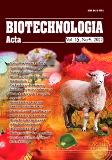ISSN 2410-7751 (Print)
ISSN 2410-776X (Online)

Biotechnologia Acta V. 15, No. 4, 2022
P. 37-40. Bibliography 9, Engl.
UDC: [577.112.083/616.931] +616-006.6
https://doi.org/10.15407/biotech15.04.037
Ya.S. Kulyk1, 2, A.A. Siromolot1, 2, D.V. Kolybo2
1Taras Shevchenko National University of Kyiv, Ukraine;
2Palladin Institute of Biochemistry of the National Academy of Sciences of Ukraine, Kyiv
Background. Better and high-potency vaccines against diphtheria are urgently needed to provide broader protection against diverse strains and subtypes. Identification of novel broadly neutralizing epitopes targeted by protective antibodies could aid in such efforts.
Aim. In this study we focused on the search of binding sites identification of anti diphtheria toxin monoclonal antibodies and their neutralizing activity to block binding of recombinant exotoxin derivates with host receptors.
Methods. Vero cells were cultured in the complete RPMI-1640 medium under standard conditions and used for flow cytometry assay. Recombinant antigens and products of tryptic hydrolysis of CRM197 and SbB were characterized by Ni2+-NTA affinity chromatography and SDS-PAGE under reducing conditions with following ECL Western-Blot using several hybridomas clones of anti-diphtheria toxin monoclonal antibodies.
Results. ECL western blot film results for clone 9.1-E11 showed the specific binding both to whole CRM197 molecule, and to almost all fragments of CRM197 formed as a result of limited proteolysis. In particular, a band corresponding to SbB in molecular weight can be identified. Thus, epitope region of the CRM197 molecule specific to 9.1-E1 mAbs is located within the structure of SbB. At the same time 16.4-E9 clone antibodies had high specificity to R-domain of SbB. In addition, both hybridoma clones antibodies have neutralizing activity against the DT binding subunit, which is a key factor in blocking between cell receptor and it ligand, C.diphtheriae exotoxin.
Conclusions. The results obtained indicate that obtained antibodies are prospective for improving new diagnostic tools and therapeutic agents, which are used for treatment and understanding of the molecular mechanisms of diphtheria pathogenesis.
Key words: diphtheria toxin, CRM197, SbB, monoclonal antibodies, proHB-EGF, epitopes mapping, neutralizing antibody.
© Palladin Institute of Biochemistry of the National Academy of Sciences of Ukraine, 2022
References
1. Sharma N. C., Efstratiou A., Mokrousov I., Mutreja A., Das B., Ramamurthy T. Diphtheria. Nature Reviews Disease Primers. 2019, 5(1), 1?18. https://doi.org/10.1038/s41572-019-0131-y
2. Bellone M. L, Puglisi A., Dal Pia F., Hochkoeppler A. Production in Escherichia coli of recombinant COVID-19 spike protein fragments fused to CRM197. Biochemical and Biophysical Research Communications. 2021, 558, 79?85. https://doi.org/10.1016/j.bbrc.2021.04.056
3. Uchida T., Pappenheimer A. M. Jr., Greany R. Diphteria toxin and related proteins. I. Isolation and properties of mutant proteins serologically related to diphteria toxin. J. Biol. Chem. 1973, 248, 3838?3844. https://doi.org/10.1016/S0021-9258(19)43810-6
4. Aw R., Ashik M.R., Islam A. A.Z.M., Khan I., Mainuddin M., Islam Md. A., Mohammad M. Ahasan, Karen M. Polizzi. Production and purification of an active CRM197 in Pichia pastoris and its immunological characterization using a Vi-typhoid antigen vaccine. Vaccine. 2021, 39(51), 7379?7386. https://doi.org/10.1016/j.vaccine.2021.10.083
5. Siromolot A. A., Krynina O. I., Kolybo D. V., Komisarenko S. V. Antiproliferative and apoptotic effects of anti-human HB-EGF neutralizing polyclonal antibodies in vitro. Experimental oncology, 2020, 42(1), 25?30. https://doi.org/10.32471/exp-oncology.2312-8852.vol-42-no-1.14145
6. Labyntsev A. J., Kolybo D. V., Yurchenko E. S., Kaberniuk A. A., Korotkevych N. V., Komisarenko S. V. Effect of the T-domain on intracellular transport of diphtheria toxin. Ukr Biochem J., 2014, 86(3), 77?87. http://dx.doi.org/10.15407/ubj86.03.077
7. Krynina O. I., Korotkevych N. V., Labyntsev A. J., Romaniuk S. I., Kolybo D. V., Komisarenko S. V. Influence of human HB-EGF secreted form on cells with different EGFR and ErbB4 quantity. Ukr. Biochem. J., 2019, 91(5), 25?33. https://doi.org/10.15407/ubj91.05.025
8. Skar D. C., Rohrbach M. S., Bodley J. W. Limited trypsinolysis of native Escherichia coli elongation factor G. Biochemistry, 1975, 14(17), 3922?6. https://doi.org/10.1021/bi00688a030
9. Hamaoka M., Chinen I., Murata T., Takashima S., Iwamoto R., Mekada E. Anti-human HB-EGF monoclonal antibodies inhibiting ectodomain shedding of HB-EGF and diphtheria toxin binding. The Journal of Biochemistry, 2010, 148(1), 55–69. https://doi.org/10.1093/jb/mvq033

